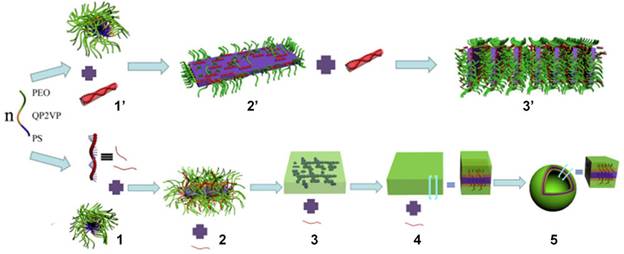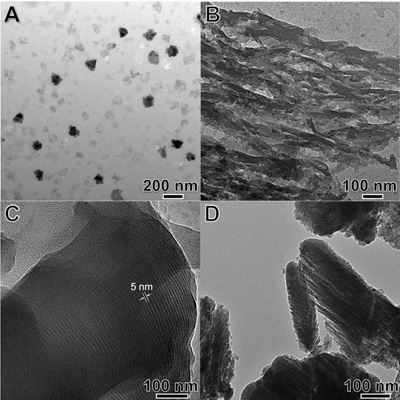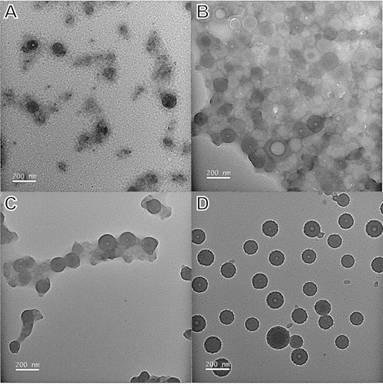www.acsprf.org
Reports: ND749090-ND7: Unimolecular Polymeric Janus Nanoparticles: Synthesis, Self-Assembly and Applications
Lei Zhu, PhD , Case Western Reserve University
1. Project Progress
In the first year, we studied the mechanism of film and vesicle formation when 26 base unit single-stranded DNA (ssDNA) was gradually added into PS31-QP2VP12-PEO68 micelle solution. In this year, we investigated 26 base pair (bp) double-stranded DNA (dsDNA) self-assembly with PS31-QP2VP12-PEO68 micelles using TEM and AFM. Typical results are shown in Chart 1.
Chart 1. Bright-field TEM images of 26 base pair dsDNA/PS31-QP2VP12-PEO68 complexes obtained at the negative-to-positive ratio (N/P) being (A) 1/118, (B) 2/118, and (D) 4/118, respectively. Inset in (B) shows the corresponding nanodiffraction pattern. (C) Tapping mode AFM height image for the complex in (B) with a profile scan in the inset.
The solution of 26 bp dsDNA (0.1 mg/mL) was slowly added using a syringe pump into 0.5 mL of triblock copolymer micelle solution (1.0 mg/mL) at a rate of 20.8 mL/h. Unlike the case for ssDNA, irregular shaped aggregates (ca. 200 nm in size) were observed at 1 h of dsDNA addition (N/P = 1/118, Chart 1A). At 2 h of dsDNA addition (N/P = 2/118), irregular shaped aggregates disappeared and elongated sheets were observed (Chart 1B and step 2' in Scheme 1). The length of most sheets was 200-500 nm and the width was 100-200 nm. Using tapping mode AFM (Chart 1C), detailed structure of the sheets was revealed. The overall height of the sheets ranged from 5 to 40 nm, and each sheet contained a few layers with each layer thickness being ca. 5 nm (see the right side step in the profile scan in the inset of Chart 1C). It was reasonable to conclude that self-assembly of dsDNA with PS31-QP2VP12-PEO68 was completely different from that of ssDNA due to the rigidity in dsDNA because either crystalline or liquid crystalline structures were formed. With further addition of dsDNA (4 h or N/P = 4/118), large aggregates were obtained (Chart 1D and step 3' in Scheme 1).
Scheme 1. Schematic representations for morphological evolution during the complexation of spherical micelles of PS31-QP2VP12-PEO68 with 26 base unit ssDNA and 26 base pair dsDNA with increasing the DNA concentration.
On the basis of the above experimental results, schematic representations for the self-assembly of 26 base unit ssDNA (last year report) and 26 bp dsDNA with PS31-QP2VP12-PEO68 micelles in solution is shown in Scheme 1. For the ssDNA complexation with a triblock copolymer micelle, there are two possibilities. First, 26 base unit ssDNA (8.6 nm in length) can condense onto (or wrap around) one micelle. Second, it can bridge two micelles together. Once the second case dominates, more micelles will aggregate together. However, due to the core-core coupling effect, anisotropic aggregation will take place to form worm-like or cylindrical micelles. Further aggregation results in structured films, which continue to transform into ultrathin featureless film with a bilayer structure due to the high chain mobility of low molecular weight PS blocks. With more ssDNA addition, these thin films become unstable and spherical vesicles form. For the 26 bp dsDNA complexation with PS31-QP2VP12-PEO68 micelles, a different morphology evolution pathway is observed because dsDNA has high chain rigidity. Elongated single crystal-like sheets are obtained from the self-assembly of dsDNA with PS31-QP2VP12-PEO68 at low dsDNA concentrations. At high dsDNA concentrations, multiple sheets stack into spherulitic aggregates.
Chart 2. Bright-field TEM images of 200 base unit ssDNA/PS31-QP2VP12-PEO68 complexes obtained at the negative to positive ratio being (A) 1/60, (B and C) 2/60, and (D) 12/60.
When the length of ssDNA changed from 26 to ~200 base units, a similar procedure was used to obtain complexation with PS31-QP2VP12-PEO68 micelles. Using a syringe pump, a solution of 200 base unit ssDNA (0.1 mg/mL) was slowly added into 0.5 mL triblock copolymer micelle solution (1.0 mg/mL) at a rate of 20.8 mL/h. At 1 h of ssDNA addition (N/P = 1/60), irregular shaped aggregates (around 200 nm) were observed by TEM (Chart 2A). As the ssDNA continued to be added into the triblock micelle solution at 2 h (N/P = 2/60), lots of ribbon-like aggregates were observed (Chart 2B). Meanwhile, we also found some thin films with well-defined alternating dark and bright structure on the same TEM grid. The dark region had a thickness of ca. 5 nm. With continued addition of 200 base unit ssDNA to 4 h (N/P = 12/60), the morphology of the aggregates became dendritic-like (Chart 2D), similar to the spherulitic aggregates for the 26 bp dsDNA/PS31-QP2VP12-PEO68 complex (Chart 1D). On the basis of these observations, we speculate that for long chain ssDNA, partial double strand and loops might form due to the Watson-Crick complementary rule. The partial double strand portion in ssDNA increased the chain rigidity and thus induced similar self-assembly as that for the 26 bp dsDNA/PS31-QP2VP12-PEO68 complex.
When we changed to the high molecular weight triblock copolymer, PS721-QP2VP191-PEO375, the self-assembly behaviour further changed. For example, the solution of 200 base unit ssDNA (0.1 mg/mL) was slowly added into 1.0 mL micelle solution of PS721-QP2VP191-PEO375 (1 mg/mL) using a syringe pump at a rate of 41.7 mL/h. At 2 h of ssDNA addition (N/P = 1:32), irregular shaped aggregates were observed (Chart 3A). At 3 h of ssDNA addition (N/P = 1.5/32), vesicles were obtained. However, all vesicles easily aggregated together (Chart 3B). At 4 h of ssDNA addition (N/P = 2/32), aggregated vesicles gradually separated (Chart 3C). Finally, at 12 h of ssDNA addition (N/P = 6/32), well-defined and separated vesicles were observed (Chart 3D).
Chart 3. Bright-field TEM images of 200 base unit ssDNA/PS721-QP2VP191-PEO375 complexes obtained at the negative to positive ratio being (A) 1/32, (B) 1.5/32, (C) 2/32, and (D) 6/32.
2. Program Impact
This project has initiated a new direction of the PI's research in the fields of supramolecular self-assembly of cationic polymer micelles and gene transfection, which may be viable for future grant applications to NSF and NIH. The postdoctoral fellow has been trained to broaden his area from organic synthesis to bio-related science and engineering, and this is expected to be beneficial to his future professional career.




